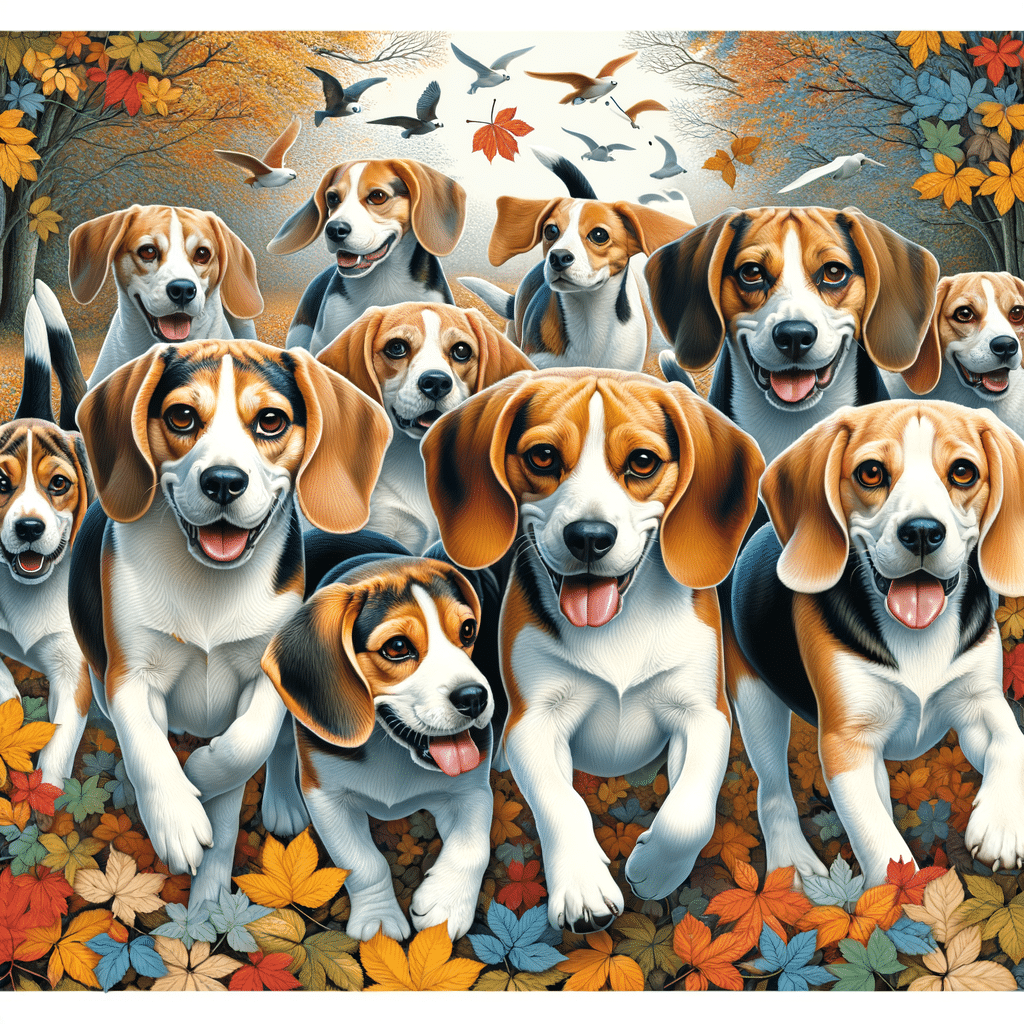When considering adding a new dog to your home, the decision often comes down to which breed best fits your family’s lifestyle, living space, and companionship needs. Comparing the distinct breed features of the beagle vs. Sharp Pei can be an invaluable tool.
In This Article
These are two popular dog breeds with some key behavioral differences. Studying them can help you find the perfect dog. Understanding the differences between the lively and compact beagle, known for its curious and friendly nature, and the distinctively wrinkled Shar Pei, recognized for its loyal and independent demeanor, is critical for prospective pet owners.
Both breeds have rich histories that contribute to their present-day temperaments and physical attributes. Originating in England, beagles have a keen sense of smell and tracking abilities, making them excellent hunting companions. Conversely, the Shar Pei hails from China, where it showed off its guarding skills. With contrasting backgrounds and traits, beagles and Shar Peis cater to different roles within a household.
Today, considerations around the health, maintenance, and social behavior of each breed are paramount. Beagles are typically sociable and require regular exercise to maintain their health, while the Shar Pei may need more dedicated grooming due to its unique skin folds. It tends to have a more reserved nature. Matching the needs of the dog with your ability as the owner to provide care, exercise, and socialization can determine the success of the relationship.
Highlights
- The beagle and Shar Pei offer different benefits that suit varied owner lifestyles.
- Each breed has a distinct history shaping its modern health, temperament, and care needs.
- Matching a dog breed’s characteristics with the owner’s capabilities is essential for a harmonious pairing.
Breed Origins and History
The beagle and Shar Pei are breeds with rich and distinct histories, having evolved from different regions and for varied purposes. The beagle was bred primarily for hunting, while the Shar Pei has a background that includes fighting and guarding.
Beagle Background
The beagle is a breed with an origin deeply entrenched in hunting. Developed in England, beagles have been traced back to Roman times, but their modern development is attributed to the 16th century when they were used for hunting small game due to their keen sense of smell and stamina.
England’s fondness for fox hunting demanded the breeding of efficient hunting dogs, positioning the beagle as a favored choice. Recognized by the AKC (American Kennel Club) in the late 19th century, the breed has since transcended its hunting origins to become a popular pet, known for its friendly and even-tempered nature.
Shar Pei History
The Shar Pei, or Chinese Shar Pei, is a breed believed to have originated in southern China, with its history extending over 2,000 years, potentially linked to the Han dynasty. Originally bred for various roles including farming, hunting, and guarding, the breed later became associated with dog fighting, a role that influenced its physical characteristics.
The Shar Pei’s distinctive loose, wrinkled skin and strong build made them difficult for opponents to grasp. Despite its fighting history, the breed faced near extinction in the mid-20th century until efforts from enthusiasts led to its rejuvenation. Today’s Shar Pei, recognized by the AKC in 1992, is typically a companion pet, treasured for its loyalty and protective instincts.
Physical Characteristics and Health
When comparing the physical characteristics and health of beagles and Shar Peis, prospective pet owners need to consider differences in appearance and size and breed-specific health concerns. These factors are vital to ensure the dog’s well-being and compatibility with its future home environment.
Appearance and Size
Beagles are small to medium-sized dogs with a muscular build. They display a variety of coat colors, including black, brown, red, and white. They typically have a friendly expression and large brown or hazel eyes. Adult beagles stand about 13 to 16 inches in height and weigh between 20 and 30 pounds on average.
In contrast, the Shar Pei is recognizable for its deep wrinkles and blue-black tongue. They have a distinctive rough coat that can come in black, brown, blue, and red, among other colors. Shar Peis are medium-sized, with a height ranging from 18 to 20 inches and a weight of 45 to 60 pounds, portraying a stockier figure than the beagle.
Common Health Concerns
Beagles and Shar Peis both have breed-specific dog health issues. If not exercised properly, beagles may suffer from obesity. They are prone to epilepsy, cherry eye, glaucoma, and beagle dwarfism, which affects their bone growth. Their average lifespan ranges from 10 to 15 years.
Shar Peis have unique health concerns due to their physical characteristics. Their skin folds can lead to cutaneous mucinosis and other skin infections. They are also prone to hereditary conditions like hip dysplasia, elbow dysplasia, entropion, and patellar luxation. Shar Peis may develop several types of cancer or suffer from distichiasis, a condition where eyelashes grow inwards. Their average lifespan is similar to the beagle, typically between 8 to 12 years.
Both breeds benefit from careful monitoring of their health by a veterinarian with knowledge of their specific needs to maintain a quality life.
Temperament and Social Traits
When considering the beagle and the Shar Pei dog, it’s crucial to understand that these breeds carry distinct behavioral patterns and social characteristics. From their interaction with families to their response to other pets, each breed brings its own unique traits to the home environment.
Behavior and Personality
The beagle is renowned for its friendly and playful nature. It often showcases high levels of energy and affectionate tendencies towards its owners. Known for being loving and happy, beagles are kid-friendly and tend to get along well with all family members. Due to their hunting heritage, beagles have a notable prey drive, which can sometimes lead to a chase if small animals are within range.
In contrast, the Shar Pei is recognized for an independent and somewhat stubborn personality, traits that can be both endearing and challenging. While they are intelligent and capable of forming strong bonds with their families, Shar Peis have guarding instincts. They are loyal and can be good guard dogs, often displaying a calm demeanor, but with the propensity to watch and protect their home.
Interaction with Family and Pets
Beagles thrive in a family setting, and their friendly disposition makes them excellent companions for children and other pets. They often seek affection and are at their happiest when part of group activities, adapting well to being members of busy households.
Shar Peis may require a more cautious approach when integrating with other pets. Although they can be affectionate towards their family, their guarding nature means they sometimes need personal space and don’t always appreciate the company of other dogs. When it comes to families, Shar Peis may prefer a calmer environment and can be particularly loyal to one person. Their interaction with children should be supervised, especially if the Shar Pei is not raised with them from a young age.
Encounters with other pets are best when carefully managed:
- Beagles: Usually dog friendly and playful with other household pets.
- Shar Peis: Can be pet friendly but may show reserved or guarded behavior, especially around unfamiliar animals.
Care and Maintenance
Proper care and maintenance are crucial to the health and happiness of both beagles and Shar Peis. Owners should pay close attention to the specific grooming, exercise, and diet needs of each breed to ensure their pets are well-cared for.
Grooming and Shedding
Beagles have a short, dense coat that is relatively easy to groom. Brushing them once a week helps to reduce shedding and keep their coat in good condition. Shedding is moderate, and more frequent brushing during seasonal changes can manage loose fur.
Shar Peis, on the other hand, have a unique coat that can either be a horse coat or a brush coat. The shorter horse coat variety sheds less than the slightly longer brush coat variety but can be pricklier and may require a special grooming glove. Shar Peis should be groomed regularly to manage shedding and prevent skin issues unique to the breed, such as infections in their skin folds.
- Beagle: Weekly brushing, occasional baths, regular ear and teeth cleaning, nail trimming.
- Shar Pei: Regular brushing, careful cleaning of skin folds, more frequent baths, regular cleaning of ears and teeth, and nail trimming.
Shedding
- Beagle: Moderate shedding.
- Shar Pei: Variable, depending on the coat type; skin care is essential.
Training and Exercise
Beagles are often eager to please and respond well to positive reinforcement training methods. They require regular exercise to manage their energy levels and to prevent boredom. Due to their high prey drive, it is important to keep them on a leash or in a securely fenced area when exercising.
The Shar Pei requires firm, consistent training from an early age to respect their owners as pack leaders. This breed may not have as high an energy level as beagles but still needs daily exercise. Compared to beagles, they can be more suited to apartment living, though they do best with a small yard. Neither dog’s breed standard would work well for dog sports.
Training Requirements
- Beagle: Positive reinforcement, patience, and consistency should include recall training due to prey drive.
- Shar Pei: Firm and consistent training, early socialization, and training may be needed to manage potential stubbornness.
Exercise Needs
- Beagle: This breed has a high energy level, needs daily walks and playtime with dog toys, and enjoys activities like tracking as a working dog.
- Shar Pei: Lower energy level; regular walks, enjoys mental stimulation through obedience training.
Each breed has particular needs in terms of food and diet. All dogs require well-balanced diets, but the quantity and specific type of food may vary based on their exercise levels and potential health issues, like bloat, which is a concern for many large, deep-chested breeds, though less common in beagles and Shar Peis. Owners should consult with a veterinarian to create an appropriate food plan for their pets.
Frequently Asked Questions
In this section, readers can find direct answers to common queries regarding the beagle and Shar Pei breeds, focusing on aspects important for potential owners.
Which breed is better for families, beagles or Shar Peis?
Beagles are widely recognized for their child-friendly nature, often showing more tolerance and playful characteristics suitable for family environments. Shar Peis can be good with children, too, but they typically require socialization and may not have the same patience as beagles.
How do beagles and Shar Peis compare in terms of intelligence?
Both beagles and Shar Peis are intelligent breeds, capable of learning and adapting to various situations. beagles excel with their keen sense of smell and tracking abilities, while Shar Peis are known for their problem-solving skills.
What are the size differences between beagles and Shar Peis?
Beagles are generally smaller and lighter, standing around 13-16 inches tall and weighing 20-30 pounds. Shar Peis are more robust. They stand at about 18-20 inches in height and can weigh 45-60 pounds, displaying a stockier build.
Can Shar Peis be recommended for first-time dog owners?
Shar Peis might present challenges for first-time dog owners because of their independent nature and the need for consistent training. On the other hand, beagles, with their friendly disposition, can be slightly more suitable for those new to dog ownership.
How do the temperaments of beagles differ from those of Shar Peis?
Beagles are often outgoing, curious, and even-tempered, thriving in social settings. Shar Peis tend to be more reserved, showing loyalty but also an independent streak that can be perceived as aloofness with strangers.
Are there any notable challenges in training Shar Peis compared to beagles?
Shar Peis may show stubbornness or dominance, which requires a firm and consistent training approach. Beagles, sometimes easily distracted by scents, respond well to positive reinforcement training methods.






